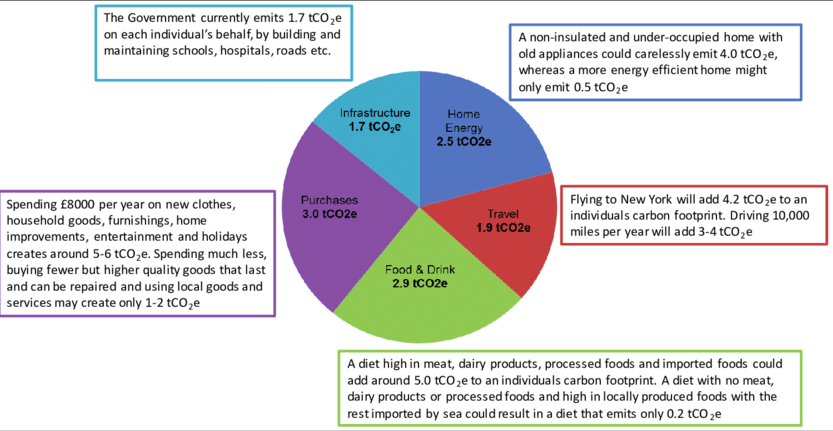
Understanding and managing carbon footprints is crucial in the modern era of climate change and the climate crisis. A carbon footprint represents the total greenhouse gases, primarily carbon dioxide, emitted by an individual, organization, or country. The UK carbon footprint calculator is a valuable online tool to measure and manage the UK carbon emissions.
The Importance of Carbon Footprint Calculators
A carbon calculator, also known as a carbon footprint calculator, is an online tool that helps individuals and businesses estimate their carbon emissions. This tool calculates emissions based on various activities, such as energy consumption, transportation, and waste generation. By using a carbon footprint calculator, you can identify areas where you can reduce your carbon emissions and make informed decisions to support the environment. An Excel spreadsheet can supplement the online calculator by providing more detailed information about the model used.
– Raising Awareness
Carbon footprint calculators play a pivotal role in raising awareness about the environmental impact of our daily activities. They empower individuals and organizations to take responsibility for their emissions and make informed decisions to reduce their carbon footprint.
– Quantifying Emissions
These calculators help quantify emissions from various sources, providing a clear picture of where reductions can be made. For businesses, this is crucial for sustainability reporting and meeting regulatory requirements. For individuals, it promotes environmentally friendly practices and supports global efforts to mitigate climate change.
How the UK Carbon Footprint Calculator Works
The UK carbon footprint calculator considers both direct emissions and indirect emissions. Direct emissions come from activities such as burning fossil fuels for heating or driving cars, while indirect emissions result from the production of goods and services we consume. This comprehensive approach ensures that all the data needed to calculate a complete carbon footprint is considered.
Direct and Indirect Emissions
Direct emissions are straightforward to measure as they come from easily identifiable sources like fuel consumption in vehicles and heating systems. Indirect emissions, however, are more complex as they encompass the emissions produced during the manufacture and transportation of goods and services. The UK carbon footprint calculator simplifies this process by breaking down activities into categories and guiding users through the data input process.
Calculating Carbon Footprints
To calculate your carbon footprint using the UK carbon footprint calculator, you need to input various data points such as your energy consumption, transportation habits, and waste production. The carbon calculator uses this data to estimate your carbon dioxide equivalent emissions, which includes carbon dioxide, methane, and nitrous oxide.
Example Calculation
For example, if you drive a car, the carbon calculator will ask for the type of fuel used and the distance driven. It will then calculate the carbon emissions based on these inputs. Similarly, it will estimate emissions from your electricity usage, heating, and other activities.
If you drive a petrol car and travel an average of 10,000 miles per year, the calculator will use the fuel efficiency of your vehicle to estimate the CO2 emissions. This would result in approximately 333 gallons of petrol consumed annually, and the calculator multiplies this by the CO2 emissions factor for petrol to determine the total emissions.
The Role of Carbon Offsets

Carbon offsets are a way to compensate for your carbon emissions by investing in projects that reduce greenhouse gases. The UK carbon footprint calculator can suggest carbon offset projects based on your emissions, helping you achieve a net-zero carbon footprint.
Carbon Offset Projects
Carbon offset projects can include reforestation, renewable energy installations, and energy efficiency improvements in developing countries. By investing in these projects, you can balance out your emissions by reducing greenhouse gases elsewhere. The UK carbon footprint calculator connects users with reputable offset providers, ensuring that the offset projects are verified and effective.
Business Use of Carbon Calculators

Businesses can use carbon calculators to estimate their carbon emissions from various processes, including business travel, production, and energy use. By calculating their carbon footprint, companies can identify opportunities for reductions and report their progress towards sustainability goals.
For example, a manufacturing company might use the calculator to assess emissions from its production processes, transportation of raw materials, and energy consumption in its facilities. By pinpointing high-emission areas, the company can implement targeted strategies to reduce its carbon footprint.
The Benefits of Using a Carbon Footprint Calculator
Using a carbon calculator offers several benefits:
-
Awareness: It raises awareness about the impact of daily activities on the environment.
-
Reduction: It helps identify areas where emissions can be reduced.
-
Support: It supports sustainability initiatives and helps in achieving net-zero goals.
-
Reporting: It aids in reporting carbon emissions accurately, which is crucial for businesses.
Key Features of the UK Carbon Footprint Calculator
-
User-Friendly Interface: The online carbon calculator is easy to use, making it accessible for everyone.
-
Comprehensive Data Input: It considers a wide range of activities and emissions sources.
-
Detailed Reports: It provides detailed reports on carbon emissions, helping users understand their carbon footprint better.
-
Support for Carbon Offsets: It suggests carbon offset projects to help users mitigate their emissions.
The Average Carbon Footprint in the UK

The average carbon footprint per household in the UK varies depending on factors such as energy consumption, transportation habits, and waste generation. The UK carbon footprint calculator helps provide an accurate estimate based on these factors.
In general, the average carbon footprint per person in the UK is around 10-12 tonnes of CO2 equivalent per year. This figure includes emissions from household energy use, personal transportation, waste production, and consumption of goods and services. By using the UK carbon footprint calculator, individuals can compare their emissions to the national average and identify specific areas for improvement.
Carbon Footprint of a kWh in the UK
The carbon footprint of a kilowatt-hour (kWh) of electricity in the UK depends on the energy sources used. Renewable energy sources have a lower carbon footprint compared to fossil fuels. The calculator helps estimate this by considering the energy mix used in your electricity consumption.
For example, electricity generated from coal has a much higher carbon footprint compared to electricity generated from wind or solar power. The UK carbon footprint calculator takes into account the proportion of renewable energy in the national grid and calculates the average emissions per kWh accordingly.
The Best Carbon Calculators
The best carbon calculators are those that offer comprehensive data input, accurate calculations, and detailed reports. The UK carbon footprint calculator stands out due to its user-friendly interface and detailed reporting capabilities.
Other top carbon calculators might include those developed by reputable environmental organizations or government agencies. These calculators often provide additional resources, such as tips for reducing emissions and links to carbon offset programs. When choosing a carbon calculator, it’s essential to select one that is regularly updated to reflect the latest scientific data and emissions factors.
How to Calculate %Carbon
Calculating the percentage of carbon emissions involves understanding the proportion of carbon dioxide in your total greenhouse gas emissions. The UK carbon footprint calculator provides this information, helping you understand your carbon impact better.
For instance, if your total greenhouse gas emissions are 10 tonnes of CO2 equivalent, and 8 tonnes of this is carbon dioxide, the percentage of carbon emissions is 80%. This calculation helps users see the dominant sources of their emissions and target reductions more effectively.
Reducing Your Carbon Footprint

Reducing your carbon footprint involves making changes to your daily activities, such as using energy-efficient appliances, reducing waste, and opting for sustainable transportation options. The UK carbon footprint calculator can help identify these areas and suggest ways to reduce emissions.
Simple actions, such as switching to LED light bulbs, reducing car usage, and improving home insulation, can significantly reduce your carbon footprint. For businesses, strategies might include investing in renewable energy, optimizing supply chains, and implementing energy-saving technologies.
Importance of Accurate Data
Accurate data is crucial for calculating your carbon footprint. The more detail you provide, the more accurate the calculations will be. The UK carbon footprint calculator ensures that all relevant data is considered, providing a precise estimate of your carbon emissions.
Providing accurate data on energy usage, transportation habits, and waste production is essential for obtaining a reliable carbon footprint estimate. The calculator’s accuracy depends on the quality of the data input, so users are encouraged to gather detailed information before using the tool.
Reporting and Progress Tracking
For businesses, reporting carbon emissions and tracking progress towards sustainability goals is essential. The UK carbon footprint calculator provides detailed reports, helping businesses meet regulatory requirements and demonstrate their commitment to reducing carbon emissions.
Detailed reports generated by the calculator can be used for internal tracking, sustainability reporting, and compliance with environmental regulations. These reports provide a clear picture of a company’s emissions profile, highlight areas for improvement, and track progress over time.
